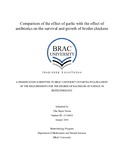Comparison of the effect of garlic with the effect of antibiotics on the survival and growth of broiler chickens

View/
Date
2018-01Publisher
BRAC UniveristyAuthor
Tuson, Olia NajonMetadata
Show full item recordAbstract
The aim of the present study was to compare the effect of garlic as feed additives with the effect of antibiotics on the survival and growth of broiler chickens. The massive use of the antimicrobial drug in poultry industries is one of the reasons for the emergence of drug-resistant microbes. Transmission of resistant pathogens from animals to humans can take place through a variety of routes, such as via direct consumption, direct contact of chickens to humans or from the manure which is later used as a fertilizer or feeds for the fish.
First of all, to conduct this study chickens were divided into four groups (T1, T2, T3, and T4). Each group consisted of 200 chickens (except T4). They were given the same poultry feed. T1 was given antibiotics and other manufactured growth promoters, T2 was given garlic, T3 was given both garlic and yogurt as feed additives and T4 was given none (only regular poultry feed: starter, grower, and finisher). T4 was taken as a control group for comparison purpose. To analyze the methods and its effectiveness, results were collected carefully; data were made on the chicken’s mortality rates, body weights, biochemical tests and antibiogram test of the feces samples collected from each group of chickens. Broiler chickens are extremely fast growing, they have been processed to grow and then slaughtered in 30-32 days. For this research purpose chickens were under observation for 30 days. In the present study, it was observed that the stool samples collected from all the groups were contaminated by bacteria from Enterobacteriaceae family (E.coli, Proteus vulgaris, Salmonellatyphi, Salmonella choleraesuis, Salmonella paratyphi A). All of the bacterial isolates were multi-drug resistant. The survival rate and the body weights of the T2 group were higher than the T1 group. Though group T4 had only 25 chickens but they all survived. The findings showed a possibility of using garlic as a prophylactic agent. Also, few physical abnormalities were observed in the chickens from T1 group which could indicate the negative impacts of chemically synthesized drugs.
